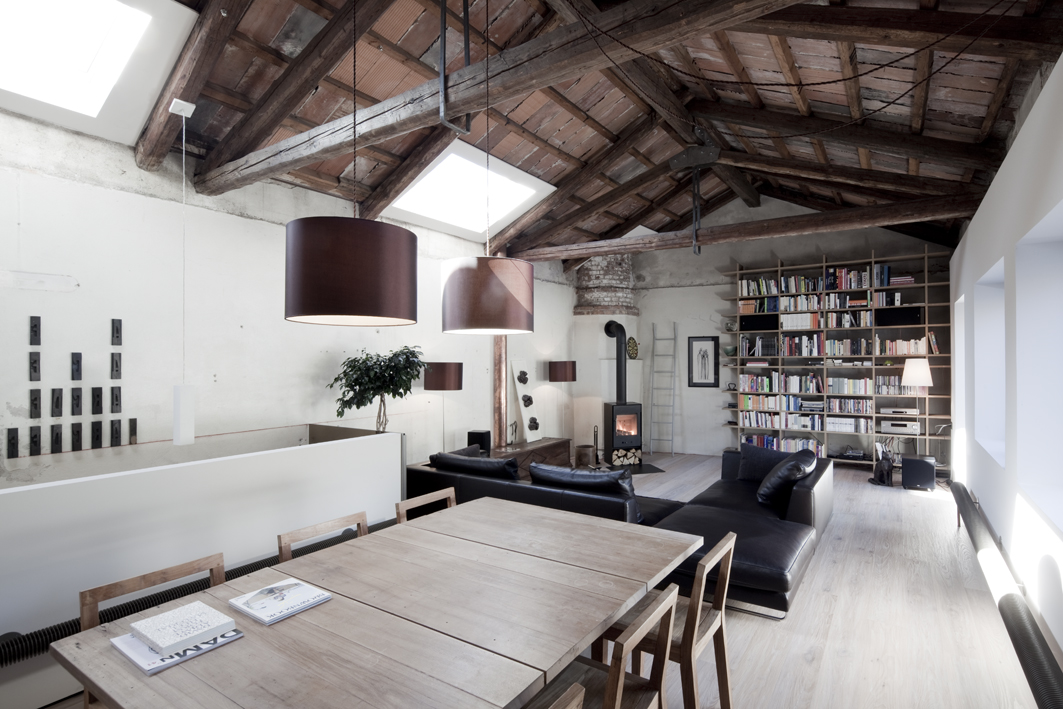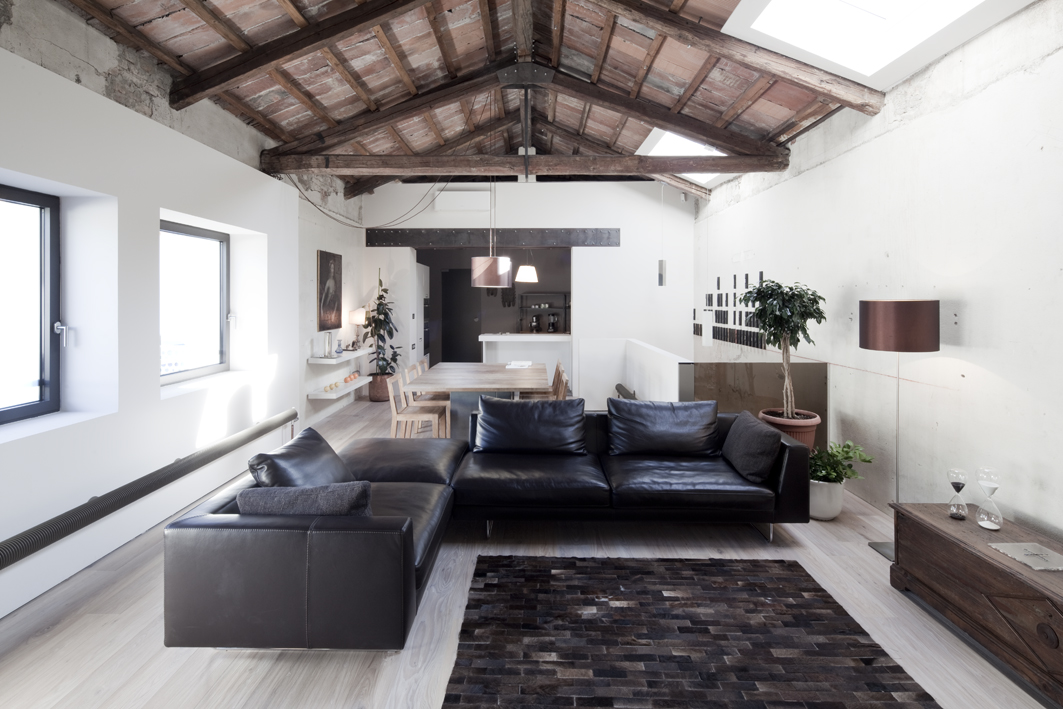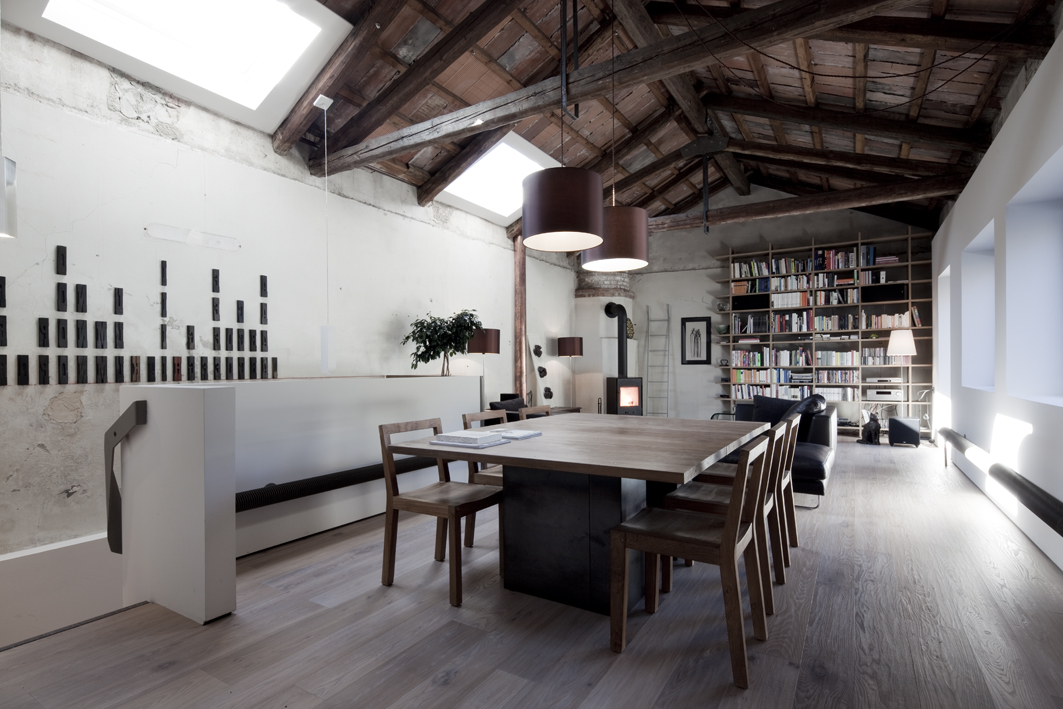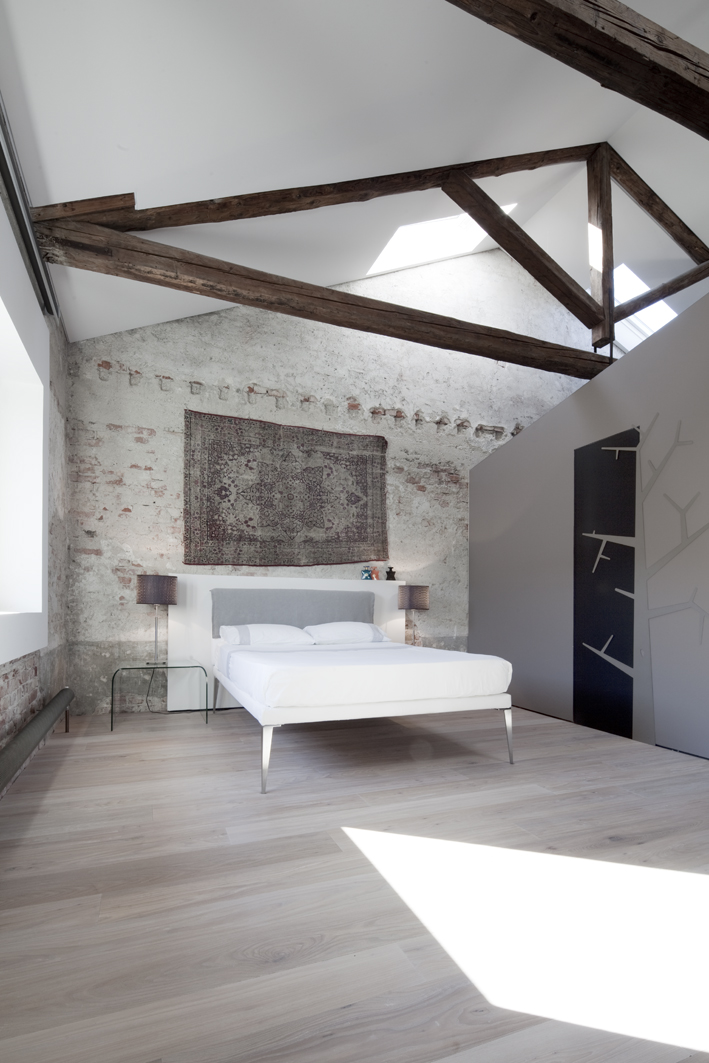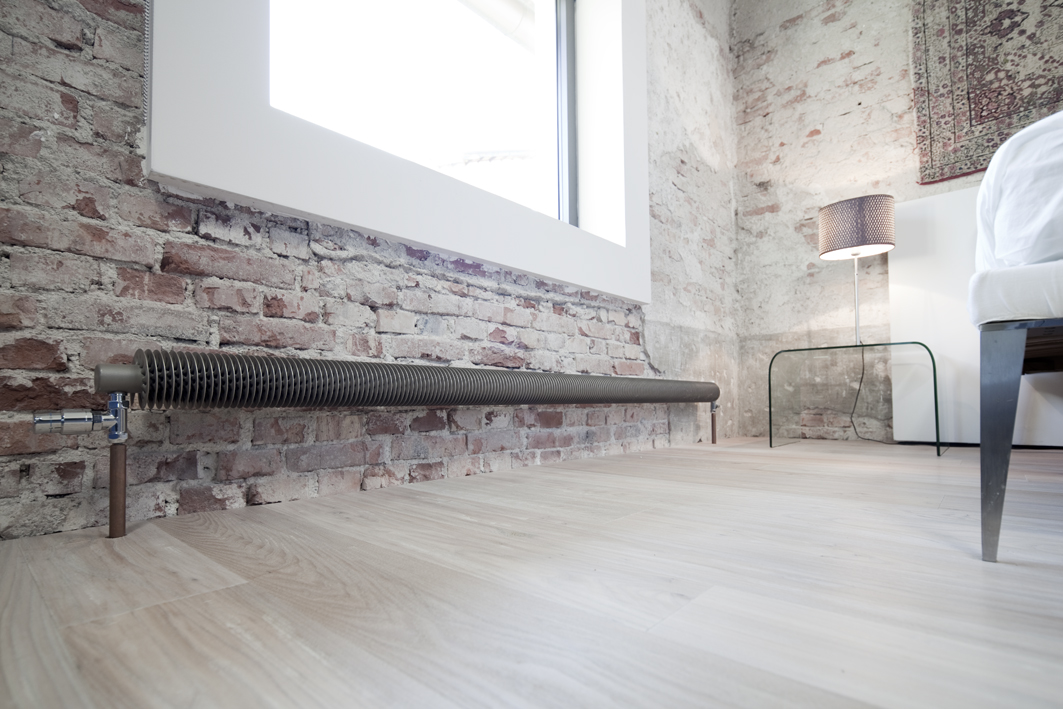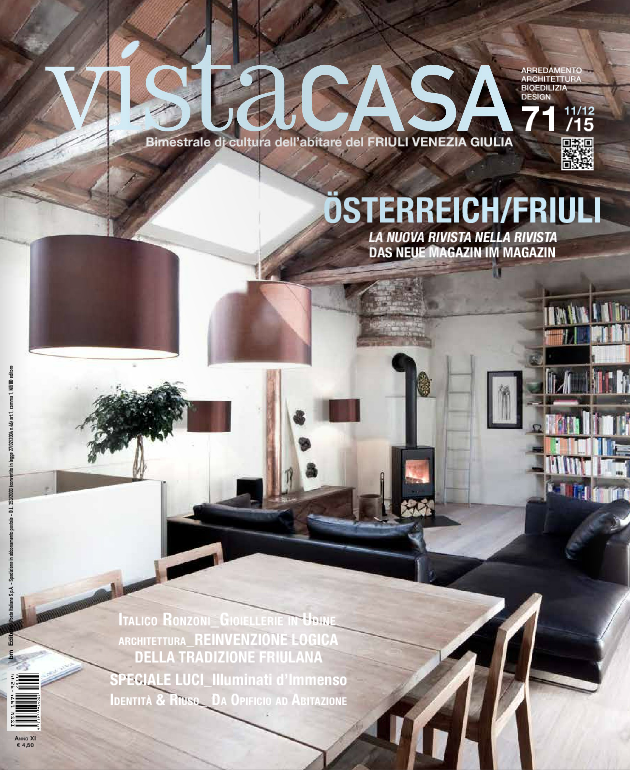From Factory to Dwelling
“… I sometimes dream of a larger […] house… which shall still consist of only one room, a vast, rude, substantial, primitive hall, without ceiling or plastering, with bare rafters and purlins supporting a sort of lower heaven over one’s head — useful to keep off rain and snow, where the king and queen posts stand out to receive your homage, when you have done reverence to the prostrate Saturn of an older dynasty on stepping over the sill; a cavernous house […] where some may live in the fireplace, some in the recess of a window, and some on settles, some at one end of the hall, some at another, and some aloft on rafters with the spiders, if they choose; a house which you have got into when you have opened the outside door, and the ceremony is over; where the weary traveller may wash, and eat, and converse, and sleep, without further journey; such a shelter as you would be glad to reach in a tempestuous night, containing all the essentials of a house, and nothing for house-keeping; where you can see all the treasures of the house at one view, and everything hangs upon its peg, that a man should use; at once kitchen, pantry, parlor, chamber, storehouse, and garret […]. A house whose inside is as open and manifest as a bird’s nest, and you cannot go in at the front door and out at the back without seeing some of its inhabitants … ” by H.D. Thoreau, “Walden” or “Life in the Woods”, 1847.
Originally a tannery where hides were finished, of which the small chimney still stands, the building was completely restructured in the early 60’s to become a printing works; in 2011-2012, the warehouse and service areas were transformed into dwellings.
The designer’s idea was to leave the building an unfinished project, remaining faithful to the stratification/juxtaposition of past projects that left their mark through its life.
Time leaves its mark on architectural elements in a sort of “living sensuality” where man, the sentient being, interacts and models the spaces he inhabits; and where these same spaces in turn influence the minds and bodies of men. The architectural project involved the creation of an open space by demolishing some interior partitions, accepting the state of the exterior walls as they were, free of inhibitions, and without compromise. Blemishes, abrasions and peeling patches were left untouched, along with scratch marks where in some places the original plaster can now be seen, as can the 3-brick thick masonry and reinforced concrete stringcourses. Removing the reed wattle false ceiling left the roofing elements in full view: trusses, purlins, joists, battens and hollow tiles, simply cleaned and treated. The deliberately ‘open’ functional plan with a variety of uses, thanks to well-organized and simple space management, is punctuated by minimalist geometric volumes, hailing to a feeling of “here and now” in contrast with the elements of the past, of something unfinished, broken and cut short, or that which will no longer be. In a dialogic equilibrium, rigour and minimalist synthesis refer to languages of a certain synchronicity, contrasting with a more nostalgic dimension, which in some ways is even a little bohemian, with the walls ‘telling’ their own story, and all in all creating an unexpected although pleasantly informal effect.

Elements of the most minute detail and parts deliberately left as-is or in any case unfinished, intertwine in an effect of reciprocal emphasis, creating a somewhat unprecedented harmony, rewriting the rules of custom.
Published on “VistaCasa” n.71 – December 2015
——
Originariamente sede di un opificio per finissaggio pellami, del quale resta testimonianza la piccola ciminiera, il fabbricato, già completamente rimaneggiato ai primi degli anni settanta per accogliere un’azienda tipografica, nel 2011-2012 è stato interessato da un intervento di recupero con trasformazione degli spazi magazzino e servizi in abitazione.
Secondo le intenzioni di progetto l’edificio viene considerato come entità non finita mantenendone evidente la stratificazione/giustapposizione degli interventi susseguitisi nel corso della sua ‘vita’.
L’azione del tempo sugli elementi architettonici, rimanda a un concetto di “sensualità dell’abitare” dove l’uomo, inteso come corpo senziente, interagisce e modella gli spazi che abita e dove i medesimi influenzano a loro volta corpo e psiche. Il progetto architettonico ha previsto la creazione di uno spazio unitario attraverso la demolizione delle, seppur poche, partizioni interne, accettando, senza inibizioni né compromessi, lo stato delle pareti perimetrali. Imperfezioni, graffiature, scrostature sono state lasciate inalterate, insieme ai graffiti, dove per alcuni ambiti, è stato fatto riaffiorare l’originario intonaco, così come i corsi a tre teste della muratura e i cordoli in cemento armato. La rimozione del controsoffitto in arelle ha poi portato a vista gli elementi del tetto, composto in capriate, arcarecci, travicelli, correntini e tavelle che sono state oggetto di semplice ripulitura e trattamento. Il programma funzionale, volutamente ‘aperto’ a mutabili destinazioni d’uso, secondo un ordinato e semplice articolarsi degli spazi, è scandito da volumi geometrici d’ispirazione minimalista che rimandano ad un qui ed ora che si pongono in confronto a quegli elementi che invece evocano memoria di quello che fu, del non finito, dello spezzato e dell’interrotto, ovvero di quel che non sarà più. In un dialogico bilanciamento, il rigore e la sintesi minimalista affini ai linguaggi di una certa contemporaneità, si contrappongono a una dimensione più nostalgica, per certi versi anche un po’ bohémien, offerta dalle pareti che ‘trasudano’ il loro vissuto, generando nel complesso un effetto di inattesa piacevolezza e informalità.
Elementi di rigoroso dettaglio e parti lasciate volutamente com’era, o comunque grezze, si interallacciano in un effetto di reciproca enfasi e per certi versi inedita armonia, al di fuori dei consueti canoni.
“… Qualche volta sogno una casa più grande… Questa casa sarà composta da una sola stanza, un grande stanzone primitivo, solido e rustico, senza controsoffitto e intonaco, con travi e traverse nude, che reggono sopra le vostre teste una sorta di basso cielo che vi protegge dalla pioggia e dalla neve, dove i pali regali del vostro baldacchino si mettano sull’attenti, quando una volta entrati voi rendete omaggio ad un Saturno strappato di un antico inquilino; una casa a dire poco cavernosa dove si può installarsi nel camino, o nell’anfratto di una finestra, ovunque nella stanza oppure in alto sulle travi con i ragni, ovunque a noi piaccia.
Una casa dove le cerimonie finiscono una volta entrati. Là dove il viaggiatore stanco può, senza più affaticarsi, lavarsi, mangiare, raccontare, e dormire, un rifugio che sarete felici di trovare in una notte di tempesta, una casa che contiene l’essenziale e nulla per governarla. Con il solo sguardo vedrete tutti i tesori della casa, tutto ciò che vi serve è lì, a portata di mano, sarà cucina, armadio, camera da letto, magazzino e granaio. Che voi entriate dalla porta anteriore o usciate da quella posteriore non potete evitare di vedere se qualcuno è in casa. L’intérieur è aperto e manifesto come un nido di uccelli. … ”
di H.D. Thoreau, Walden. Vita nei boschi, 1847.
* riferimento così come citato in “Cosmologia Portatile” di Italo Rota
